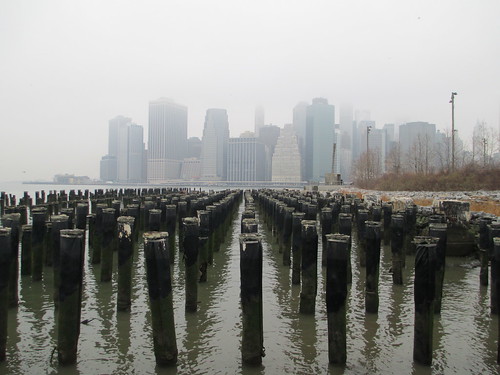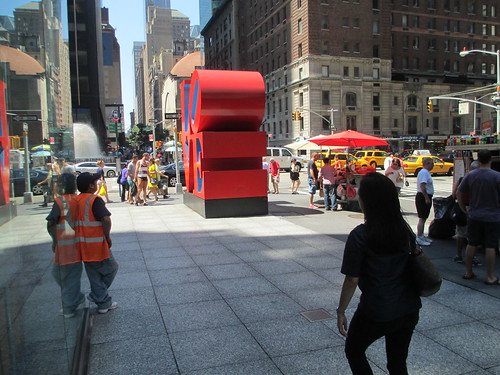A few nights in the last few weeks, I’ve been working late
and, realising I needed groceries but would miss the closing time of stores
near my apartment, I’ve opted to make a treat out of a chore. I’ve headed five
blocks north from my office and ridden into Central Park ,
heading for the Fairway Market on Broadway. I’ve swept downhill from Central
Park South, leaving behind the oppressive heat thrown off by New York ’s buildings and streets in the
current heatwave for the marginally cooler park, surrounded by trees yet
overlooked by skyscrapers.
 |
| Central Park: a treat to ride in - for those with a taste in heated manure |
But on Thursday night, after a particularly sulphurously hot
day, the experience had an unexpected, added edge. Almost as if I’d ridden into
a cloud of some pollutant, I found myself inhaling as thick a concentration of
horse manure smells as I’ve ever experienced. The tourist carriages that I
often follow in the morning from their stables on the lower west side had
clearly been busy that day, I realised. That had left a generous coating of
manure baking on the asphalt in 100F heat, with predictably stinky results.
The experience brought home to me how vital a part smell
plays in the full-frontal assault of riding a bike in any large city during a
heatwave. In New York ,
however, it currently plays a particularly special role. The city has been
better in its gentrification push over the last 20 years at improving how it
looks than how it smells. Many of the odours consequently represent the forces
that even so controlling an administration as Michael Bloomberg’s still hasn't managed to rein in. They tell a story about the city that’s wafted only into
the nostrils of the still fairly select bunch of people prepared to ride a bike
in New York
on a day when the thermometer is showing over 90F and one’s glasses steam up
instantly one steps outdoors.
There are, of course, some smells that persist year-round. Sometimes when I'm riding by the East or Hudson Rivers, a boat's wash slaps into the promenade. New York is a maritime city and that the
rivers, as well as carrying water from upstate, are inlets of the sea. It’s the
smell of the secret of New York ’s success – a gateway
between the interior that vessels sailing up the Hudson River serve and the wide
Atlantic Ocean out beyond the harbour.
The same goes for the smell that meets me as I speed on my
bike down the western side of the Manhattan
Bridge Manhattan . In my mind’s eye, the smell
forever has me sitting in one of the countless eating places in the heart of Hong Kong , at a Spartan formica table, with plates
of steaming food being brought to me. The two places smell exactly the
same.
Then there are the smells that testify to how my fellow New
Yorkers’ behaviour changes as the heat rises.
Earlier in the summer, when the Hudson River Park
The path is at least less cluttered now that the park is
generally open late into the night. But, as I ride by the park’s
helpfully-placed bushes, the strong smell bears testimony to park users’
continued desire to smoke dope while watching New Jersey ’s lights becoming fuzzier and
fuzzier.
The city’s
public parks smell different in daytime heat too. Taking myself once again out of the city on
Saturday, I rode up (for the first time) to The Bronx, bound over the city line
to Westchester County
But probably the most telling smells are the ones that
testify to how much organic matter still lies festering, largely unnoticed,
round the greatest city on earth.
It’s tempting to think of New York as forged out of concrete and
steel, an entirely manmade creation. I’ve recently discovered that that’s not
entirely fanciful. Midtown and lower Manhattan
sprouted their skyscrapers precisely because the bedrock there is close to the
surface. Many of the buildings there are plugged straight into the solid,
unyielding bedrock, with no messy soil in between.
But the stench in Central Park
is a reminder how the city continues to consume vast quantities of organic materials.
Horses’ oats and hay end up caked on Central Park ’s
asphalt. The smell of rotting food from humans’ garbage, which I often smell as
I cycle past the sanitation department depot in Chelsea , is far more widespread in summer. It
hangs around the big piles of garbage bags piled on the sidewalk as the sun
makes the discarded fruit and vegetables inside decay all the faster.
Worse still is the stink emanating from some of the drains. The
city might have eliminated graffiti and
broken windows above ground. But there’s something far less readily controllable
about the life of a drain. The whiff that wafts up from some gratings puts me
in mind of a slum in Mumbai or Kolkata, where the same malodorous ingredients
mingle in the open air.
Yet the smelly life that springs forth when the mercury
jumps to 90 is far less surprising to a cyclist than to most people. Cyclists
are close enough to see the rat dart across the cycle path, smell the garbage
truck that’s blocking the road and notice year-round the surprising number of
horses still at work in the city. All testify to a secret, natural life that
teems under the city’s streets, in its open places and in hidden-away stables. Cities have been giving off these smells since the dawn of civilisation - the odour of people living close together satisfying their various natural needs. However much he or she might smarten up the city's look, no future mayor looks likely to eliminate them.



Just this morning as I rode to the next town over, I wrinkled my nose as I passed one of the local bars. There's something about "morning after" bar smell that is unique and revolting.
ReplyDeleteBut while great minds may think alike, a great smellers observe similar things, only you write about them in a way that engages!
Smell . . . Bike On!
SouthLakesMom,
DeleteThanks for your comment - and your kind words.
You're right about the morning-after bar smell. Mind you, I lived for a few years in Edinburgh, one of the world's great brewing cities, near the Scottish & Newcastle Brewery. While I love beer, the stench from a large brewery truly ranks with "wet dog" among the most disgusting smells known to man.
All the best,
Invisible.
You write, "The city has been better in its gentrification push over the last 20 years at improving how it looks than how it smells." I couldn't disagree more. Air pollution is considerably -- I would even say profoundly -- less pronounced now than in the early 1990s. The formerly constant acrid sensation in the mouth, throat and lungs from breathing in particulates, carbon monoxide, and smog has largely been banished -- except of course in neighborhoods burdened with bus depots, oil tank farms and the like. Similarly, if subjectively, odors from rotting food, trash, homo sapiens, etc. all are less evident as well. Yes, of course, smells of all kinds abound more in summer than winter, but the secular trend downward is unmistakable.
ReplyDeleteCharles,
DeleteThank you once again for your wise commenting.
I didn't really mean that the smell hadn't got better. I meant that the looks had improved faster than the smells. But your knowledge and experience of the city is vastly greater than mine, so perhaps you think the smell has improved faster than the looks have.
I must say my impression remains that the graffiti-scarred city of 25 years ago has improved its looks out of all recognition. If the smell has improved more it must have been really, really stinky back when.
But I bow to your superior learning...
Invisible.